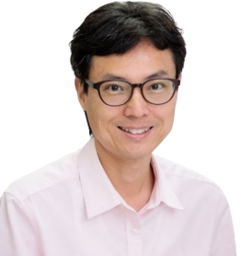PROGRAM
PROGRAM
-
PLENARY

Hyunsoo Yang
National University of
Singapore, SingaporeSpin-based Nonvolatile Memories, Unconventional Computing, and Energy Harvesting
Biography : Hyunsoo Yang is a Professor in the Department of Electrical and Computer Engineering, National University of Singapore (NUS), working on various magnetic materials and devices for spintronics applications. He worked at C&S technology and Intelligent Fiber Optic Systems, California.
He received his Doctorate from Stanford University. From 2004-2007, he was at IBM Almaden Research Center. He has authored more than 270 journal articles, given 200 invited presentations, and 20 patents.
Major Achievement : He was a recipient of the Outstanding Dissertation Award from the American Physical Society (GMAG), IEEE Magnetics Society Distinguished Lecturer, Minister of Science ICT award, Mid-Career Award of the IEEE Magnetics Society, AAIA Fellow, and IEEE Fellow.
Lecture Summary : Magnetic tunnel junction (MTJ)-based true random number generators (TRNGs) provide distinct advantages over conventional CMOS implementations. We demonstrate an MTJ-based TRNG, characterize the entropy of its raw output, and extract random bits with provable security. Beyond randomness, MTJs also enable unconventional computing.
We realize a proof-of-concept computing system that employs MTJs to implement sigmoidal activation functions, enabling the training of a neural network for speech separation. Furthermore, we present an experimental Ising computer comprising 250 MTJs, which successfully solves representative NP-hard problems.
In parallel, we integrate electrically connected spin-torque oscillators (STOs) to demonstrate a battery-free energy-harvesting system, converting wireless RF energy into usable power for electronic devices such as LEDs. We also highlight emerging opportunities for spin-orbit torque devices based on 2D materials, and discuss magnon-mediated spin torques with antiferromagnets as a pathway to reducing Joule heating and energy dissipation.
-
PLENARY

Dieny Bernard
SPINTEC, FranceThe Assets of Magnetism for Biotechnologies and Biomedical Applications
Biography : Dr B.DIENY has been conducting research in magnetism and spin electronics for 35 years. In 2001, he launched SPINTEC laboratory (Spintronics and Technology of components) in Grenoble and cofounded two startup companies in 2006 and 2014. He received two Advanced Research grants from the European Research Council in 2009 and 2014 related to hybrid CMOS/Magnetic Integrated Electronics.
He was nominated IEEE Fellow in 2010, received the De Magny Prize from French Academy of Sciences in 2015, the IEEE Magnetics Society Achievement Award in 2019 and has been nominated Knight of the Legion of Honor in 2025. He published more than 500 papers primarily in the field of nanomagnetism and spinelectronics, and filed more than 75 granted patents in particular on Magnetic Random Access Memory technology. His field of expertise covers a broad spectrum from basic research in nanomagnetism and spin-electronics to functional spintronic devices. In 2009, he also launched an activity at the interface between nanomagnetism and biology with a particular focus on magnetically induced mechanical stimulation of cancer cells and pancreatic cells with potential applications for cancer and diabetes treatments.
Major Achievement : First development of spin-valves introduced in hard disk drives in 1998, discovery of perpendicular anisotropy at magnetic metal/oxide interface (2002), various innovative concepts of MRAM (2002-2023), demonstration of destruction of pancreatic cancer cells without affecting healthy cells by magneto-mechanical stimulation of the cells (2024).
Lecture Summary : Magnetism has emerged as a versatile and transformative tool in biotechnology and biomedicine, driving innovation across diagnostics, therapeutics, and biotechnological applications. In diagnostics, magnetic technologies enable high-resolution, non-invasive imaging through modalities such as Magnetic Resonance Imaging (MRI), Magnetic Particle Imaging (MPI), and Magnetoencephalography (MEG). Magnetic particles, when combined with sensitive magnetic field sensors, also facilitate precise cell sorting and pathogen detection, enhancing the accuracy and efficiency of biological assays.
Therapeutically, magnetism offers both direct and indirect approaches to treatment. Transcranial Magnetic Stimulation (TMS), now clinically approved for severe depression, exemplifies the direct use of magnetic fields to modulate neural activity. Indirectly, in the context of cancer therapy, magnetic nanoparticles enable targeted drug delivery, localized hyperthermia, and magneto-mechanical stimulation of cancer cells. Recent advancements have further expanded these applications: magneto-mechanical stimulation has been shown to trigger insulin secretion in pancreatic cells, opening new possibilities for diabetes management, while magnetogenetics and oriented axon growth hold promise for neuroregeneration and neurodegenerative disease treatment.
The unique strengths of magnetism in these fields lie in its ability to penetrate deep into biological tissues, enabling non-invasive and remote control of biological processes. Magnetic techniques also offer high spatiotemporal precision, allowing for localized and targeted interventions. Additionally, magnetism supports multimodal integration with other technologies and exhibits theranostic potential, combining diagnostic and therapeutic functions in a single platform.
This lecture will begin by exploring the diverse applications of magnetism in medicine, highlighting its transformative potential. It will then focus on our research on magneto-mechanical stimulation, specifically its use in the selective destruction of pancreatic cancer cells while preserving healthy tissue. Finally, the talk will discuss the challenges and future directions in translating magnetic technologies from the laboratory to clinical practice, underscoring their potential to revolutionize next-generation diagnostics and therapies.
